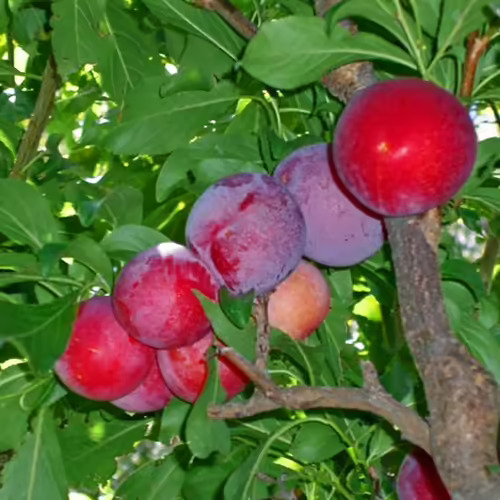The Benefits Of The Plum Fruit Tree
Human civilization is deeply intertwined with Prunus domestica, or theplum tree, which dates back thousands of years to its earliest cultivation.The areas of the Caucasus, Anatolia, and the Caspian and Black Sea regions are believed to be the origin point of this species which ancient cultures treasured. Historical records from Mesopotamia and Persia first documented this fruit-bearing species which served as both a dietary staple and a key trade item.
The Roman Empire's territorial growth led to the concurrent expansion of Prunus domestica cultivation throughout Europe via trade routes and military conquests. The Romans perfected the growing process by choosing fruit trees that produced the best quality fruit. During the Middle Ages, European monasteries became vital to preserving the species since monks grew it within their orchards for food and medicine. European colonizers transported Prunus domestica to the New World during their exploratory expeditions, which led to the species' establishment in new regions and its secure role in present-day agriculture.
Plum Fruit Tree Medicinal Uses Through the Ages
Prunus domestica has earned recognition throughout history for its dual roles as a tasty fruit and a source of medicinal benefits. Historical medical practitioners from Greece and Rome such as Hippocrates and Galen recorded Prunus domestica as a remedy for digestive disorders. People widely recognized the fruit's natural laxative properties which made it a common prescription for treating constipation and supporting digestive health.
Herbalists in the Middle Ages prepared infusions from dried fruit to treat digestive issues. Traditional Chinese medicine incorporated Prunus domestica to maintain internal system equilibrium and address fever, dehydration, and gastrointestinal problems.

Research has verified that the fruit possesses substantial amounts of fiber and sorbitol together with antioxidants which enhance digestive function, protect heart health and maintain bone density thus supporting historical medical uses. Its rich profile of vitamins and minerals including potassium and vitamin K makes it a worldwide staple in natural health practices.
First Discovery and Early Uses
The precise discovery date of Prunus domestica remains unknown but archaeological findings show its seeds were found at sites that date back thousands of years. This species' wild ancestors spread widely throughout Eurasia and their fruits served as an important food source for early hunter-gatherer societies.
The transition to agriculture led early farmers to identify the fruit's potential and start selective cultivation based on size, sweetness, and texture. Throughout centuries of development this fruit transformed from a foraged item into an essential cultivated product which became a mainstay at ancient marketplaces and royal gatherings. The ability to dry and store this produce made it a sought-after commodity for trade between Persia and Egypt.
A Stunning Addition to Landscapes
The Plum Fruit Tree provides fruits while also serving as an ornamental treasure for gardens and landscapes. People grow this plant because it produces seasonal fruits along with stunning visual beauty. In springtime branches burst forth with clusters of soft white or pale pink blossoms that create an otherworldly spectacle resembling clouds drifting through the air. Eco-friendly landscapes benefit from the presence of fragrant flowers which serve as a strong attractant for pollinators.
During seasonal changes, lush green leaves create a peaceful cover while fruit develops colors spanning deep purple to golden yellow. During autumn months the leaves transform into warm shades of orange and red which enhances its visual charm. Gardeners and landscapers favor Prunus domestica for its dual purpose: a provider of both beauty and bounty. Prunus domestica grows successfully as an individual tree and fits well in orchard settings or as an aesthetic espalier against walls and fences.
Plum Fruit Tree Distinctive Appearance and Seasonal Beauty
Prunus domestica shows an elegant form through its gracefully arching branches which form a rounded or slightly oval canopy. With its 10 to 20 feet height range this tree remains easily manageable which allows for versatile integration into different landscape designs.
The tree starts with a smooth grayish-brown bark which becomes textured with age. Leaves display an ovate shape with finely serrated edges as they start off in brilliant green and transform into autumnal shades. Spring brings forth abundant blooms before leaves completely develop their full shape, signaling the future growth of fruit.
Fruit size and color differ according to the specific cultivated variety. The fruits exhibit either an oblong or round shape while showcasing a vibrant array of deep purples, dusky blues, golden yellows, and crimson reds. The exterior skin of the fruit maintains a smooth waxy texture and the interior flesh delivers both juicy and fragrant tastes which span from deep sweetness to enjoyable tanginess.
Rare Wildlife and Beneficial Pollinators
The Plum Fruit Tree provides essential resources for wildlife species in addition to its use in agriculture and decoration. Numerous pollinators like honeybees, bumblebees, and butterflies flock to the tree during its flowering period due to its fragrant blooms. The insects involved in fruit development perform essential functions that support the wellbeing of nearby plants.
A range of birds including cedar waxwings and orioles find food in the ripening fruits of this tree in areas where it grows. Small mammals such as squirrels and foxes find food in fallen fruit and nesting birds use the dense foliage as shelter.
Prunus domestica serves as a vital host plant for larvae of specific moth and butterfly species which boosts its ecological significance. Specialized solitary bees which serve as rare pollinators show a preference for its flowers that makes it an excellent choice for wildlife-friendly gardens. Its support for multiple species helps maintain ecosystem balance while increasing biodiversity.
Plum Fruit Tree A Legacy That Endures
The Plum Fruit Tree represents a timeless emblem of nature’s bountiful gifts throughout its millennia of existence. Ancient civilizations first recognized its value and now modern gardens and orchards continue to appreciate its aesthetic appeal alongside its multifunctional uses and health benefits. Both gardens' aesthetic value and ecological support benefit from their presence while their role in human history and natural ecosystems becomes evident through their support of pollinators and wildlife.